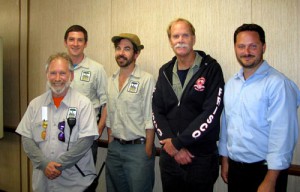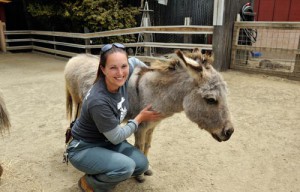A combination of a high-profile media campaign, legal strategy, political action, and membership solidarity has culminated in a major win for worker and public safety at the San Francisco Zoo.

San Francisco Zoo Teamsters 856 Bargaining Team,(L-R) Steve Levitt, David Carroll, Corey Hallman, Wesley Haug and Representative Tim Jenkins.
In response to the 2007 fatal mauling of a teenager by a tiger, the San Francisco Zoo installed a “Code Red System”. The system, which was intended to protect the public and zoo workers in emergencies,
included personal panic buttons for keepers working with dangerous animals, a public address system to alert the public to find shelter and would automatically call police when activated.
However, the system was plagued with problems from the beginning – panic buttons were easy to accidentally set off and suffered water damage. The public address system stopped instructing people to find shelter, instead only sounding an alarm and police were no longer automatically alerted. Zoo management unilaterally decided to mount the personal panic buttons on walls, some of which were not connected to the system at all.
Numerous members had brought the system’s failure to management’s attention in nearly two dozen separate safety meetings to no avail. In fact, Teamsters 856 members were removed from safety committee and armed response team after voicing their concerns – a move that was met with National Labor Relations Board charges against the employer by the union.
After management’s failure to acknowledge the inoperable system, members decided to propose improved safety measures when contract negotiations began last October. When Zoo management again refused to discuss the broken Code Red System, a multi-faceted approach was taken to resolve the issues, including filing a lawsuit compelling the Zoo to turn over data to prove the system was not working properly, taking an overwhelming no-confidence vote in the Zoo’s executive director, reaching out to politicians and the city’s Joint Zoo Committee, planning a possible protest at the Zoo’s annual fundraising gala, and working with the media to shed light on the dangers at the Zoo.
On April 24, ABC 7 aired a story featuring three San Francisco Zoo Teamsters 856 members, Corey Hallman, Wesley Haug and Steve Levitt revealing serious safety concerns they had with the Zoo’s Code Red System and management’s rigid refusal to acknowledge problems even existed within the system, let alone work toward a solution. The decision to go public was a final resort for the longterm employees.
“It was our last option—we had exhausted all avenues,” said Hallman. “People’s lives were at stake.”
The day the ABC 7 story aired, the Zoo announced that it would be upgrading its radio system to include panic buttons for employees working with dangerous animals.
“It’s disgraceful that we had to go to these lengths to get the Zoo to implement its own safety procedures, but I’m very proud to have worked with these courageous members who took a very public stand to make the Zoo a safer place for everyone—visitors and employees alike,” Tim Jenkins, Teamsters 856 representative who also appeared in the news story.
The comprehensive strategy succeeded, and a Federal Mediator was brought in to accelerate negotiations. After seven 12-hour days of Federal Mediation, Teamsters 856 and the Zoo reached an agreement that included member involvement in the implementation of an upgraded safety system and an agreement to use an outside neutral safety expect to resolve disputes. “I’ve never had as solid a bargaining team, who had the full support and backing of the rank and file membership. This is the best – easily,” Jenkins said.
While the new four-year agreement also contains significant gains in wages, retirement security, and other language improvements for the close to 150 Teamsters 856 members at the Zoo, the most important aspect is the assurance of properly working safety equipment and member participation in the implementation of safety procedures. “San Francisco Zoo Teamsters exemplify what working hard and fighting smart is all about —a determination and willingness to fight at the bargaining table and beyond,” said Teamsters 856 Secretary-Treasurer and Principal Officer Peter Finn.
“Their unwavering resolve to do the right thing resulted in tremendous safety achievements for everyone who visits and works at the San Francisco Zoo,” said Finn, who also served as the lead negotiator during the last stages of bargaining.
Levitt is hopeful that the struggle will have a lasting positive effect on the management’s approach to employee culture at the Zoo. “We still have work to do, but we’re on the road to change,” he said.

